SSH provides secure command-line access to remote servers, ideal for managing Linux systems, while RDP offers a graphical interface primarily used for Windows environments, enabling remote desktop control. Explore the differences to determine which protocol best suits your remote access needs.
Comparison Table
| Feature | SSH (Secure Shell) | RDP (Remote Desktop Protocol) |
|---|---|---|
| Primary Use | Secure command-line access | Graphical remote desktop access |
| Protocol | TCP port 22 | TCP port 3389 |
| Security | Strong encryption with public-key authentication | Supports encryption and Network Level Authentication (NLA) |
| Operating Systems | Linux, macOS, Windows (via clients) | Windows mainly; clients available for macOS, Linux |
| Performance | Low bandwidth, fast for text-based tasks | Higher bandwidth needed for graphical desktop |
| Use Cases | Server management, secure file transfer (SFTP) | Remote administration, desktop sharing, application use |
| Port Forwarding | Supported (local, remote, dynamic) | Not natively supported |
| Session Type | Command-line interface | Full graphical user interface |
Introduction to SSH and RDP
SSH (Secure Shell) is a cryptographic network protocol primarily used for secure remote command-line access and administration of Unix-based systems, providing encrypted communication between client and server. RDP (Remote Desktop Protocol), developed by Microsoft, enables users to connect to another computer over a network connection, offering a graphical interface for remote desktop sessions mainly on Windows systems. Both protocols facilitate remote management but differ in functionality, security features, and typical use cases, with SSH emphasizing secure shell access and RDP focusing on full desktop experience.
Core Differences Between SSH and RDP
SSH (Secure Shell) provides encrypted command-line access primarily for Unix-based systems, enabling secure remote management and file transfers via protocols like SCP and SFTP. RDP (Remote Desktop Protocol) offers graphical remote desktop access designed for Windows environments, allowing users to interact with the remote system's GUI as if physically present. Your choice depends on whether you require secure terminal access (SSH) or full graphical remote control (RDP) for system administration.
Security Features: SSH vs RDP
SSH (Secure Shell) offers robust security features like strong encryption, key-based authentication, and secure tunneling, making it highly resistant to interception and brute-force attacks. RDP (Remote Desktop Protocol) provides encryption and network-level authentication, but it is more vulnerable to exploits without proper configuration, such as enforcing strong passwords and limiting access. Your choice should consider SSH's inherent security advantages for secure remote terminal access versus RDP's ease of use for graphical desktop sessions, balanced with additional protective measures.
Performance and Resource Usage
SSH provides faster performance and lower resource usage compared to RDP, as it transmits only command-line data without rendering a graphical interface. RDP requires more bandwidth and CPU resources because it streams the entire desktop environment, impacting performance on slower networks or devices with limited processing power. Your choice between SSH and RDP should consider the trade-off between lightweight access and the need for graphical interface functionality.
Platform Compatibility
SSH offers broad platform compatibility, supporting Unix, Linux, macOS, and Windows environments through various client implementations, making it ideal for secure remote management across diverse systems. RDP is primarily designed for Windows platforms, providing seamless remote desktop access to Windows servers and workstations but has limited native support on non-Windows operating systems. Cross-platform RDP clients exist, yet SSH remains the preferred choice for consistent, secure, and versatile remote command-line access across multiple operating systems.
Use Cases: When to Use SSH or RDP
SSH is ideal for secure command-line access to remote servers, making it suitable for system administrators managing Linux or Unix-based environments. RDP is best used for accessing and controlling Windows desktops with a graphical user interface, enabling remote work and application use. Choose SSH for script execution and server maintenance, while RDP fits tasks requiring full desktop experience and graphical applications.
Ease of Setup and Configuration
SSH offers a straightforward setup with minimal configuration, primarily designed for secure command-line access to remote servers using public key authentication or passwords. RDP requires more complex configuration to enable graphical remote desktop access, often involving network settings, firewall adjustments, and proper user permissions on Windows systems. You will find SSH easier to configure for quick, secure remote management, while RDP demands more effort but supports a complete desktop experience.
User Experience: CLI vs GUI Interfaces
SSH offers a command-line interface (CLI) that provides powerful, text-based control ideal for users familiar with terminal commands, enabling efficient remote server management. RDP delivers a graphical user interface (GUI) that mirrors a full desktop environment, enhancing accessibility and ease of use for users who prefer visual interaction and multitasking capabilities. Your choice between SSH and RDP depends on whether you prioritize streamlined command execution or a comprehensive graphical user experience.
Common Vulnerabilities and Mitigation
SSH and RDP commonly face vulnerabilities such as brute force attacks, weak authentication, and unpatched software exploits. Implementing multi-factor authentication, strong password policies, and regularly updating both SSH and RDP clients significantly reduces the risk. You can further enhance security by limiting access via IP whitelisting and using encrypted tunnels to protect data transmission.
Conclusion: Choosing the Right Protocol
SSH excels in secure remote command-line access, ideal for managing Linux servers with encrypted connections and port forwarding capabilities. RDP provides a graphical interface suited for Windows environments, enabling full desktop control and seamless application use over networks. Selecting between SSH and RDP depends on the required interface type, operating system compatibility, and security needs.
SSH vs RDP Infographic

 solderic.com
solderic.com